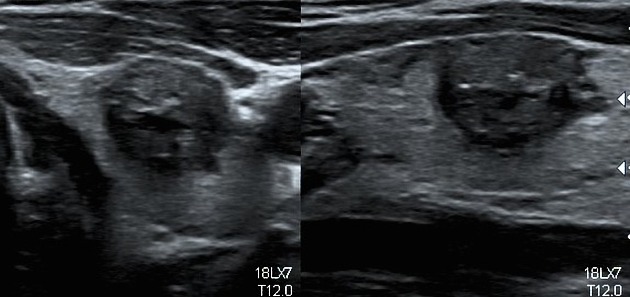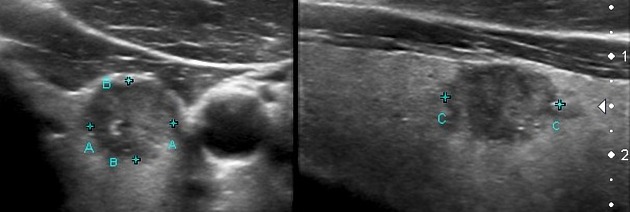Papillary thyroid cancer echocardiography or ultrasound: Difference between revisions
No edit summary |
|||
| Line 6: | Line 6: | ||
==Key Ultrasound Findings in Papillary thyroid cancer== | ==Key Ultrasound Findings in Papillary thyroid cancer== | ||
The ultrasound is a useful test to distinguish solid from cystic lesions and to identify calcifications.<ref>{{cite news|url=http://findarticles.com/p/articles/mi_qa3725/is_200607/ai_n16598095/|title=Papillary Thyroid Carcinoma: An Overview|date=|accessdate= 2010-07-15 | work=Archives of Pathology & Laboratory Medicine | year=2006}}</ref> | The ultrasound is a useful test to distinguish solid from cystic lesions and to identify calcifications.<ref>{{cite news|url=http://findarticles.com/p/articles/mi_qa3725/is_200607/ai_n16598095/|title=Papillary Thyroid Carcinoma: An Overview|date=|accessdate= 2010-07-15 | work=Archives of Pathology & Laboratory Medicine | year=2006}}</ref> | ||
* The thyroid ultrasound is also very effective to discover microcarcinomas, which refer to very small carcinomas (<1 cm).Papillary carcinoma within the thyroid usually appears as a solitary mass usually with an irregular outline, located in the subcapsular region and demonstrating vascularity.<ref name="pmid15770036">{{cite journal| author=Lyshchik A, Drozd V, Demidchik Y, Reiners C| title=Diagnosis of thyroid cancer in children: value of gray-scale and power doppler US. | journal=Radiology | year= 2005 | volume= 235 | issue= 2 | pages= 604-13 | pmid=15770036 | doi=10.1148/radiol.2352031942 | pmc= | url=http://www.ncbi.nlm.nih.gov/entrez/eutils/elink.fcgi?dbfrom=pubmed&tool=sumsearch.org/cite&retmode=ref&cmd=prlinks&id=15770036 }} </ref> | * The thyroid ultrasound is also very effective to discover microcarcinomas, which refer to very small carcinomas (<1 cm).Papillary carcinoma within the thyroid usually appears as a solitary mass usually with an irregular outline, located in the subcapsular region and demonstrating vascularity.<ref name="pmid15770036">{{cite journal| author=Lyshchik A, Drozd V, Demidchik Y, Reiners C| title=Diagnosis of thyroid cancer in children: value of gray-scale and power doppler US. | journal=Radiology | year= 2005 | volume= 235 | issue= 2 | pages= 604-13 | pmid=15770036 | doi=10.1148/radiol.2352031942 | pmc= | url=http://www.ncbi.nlm.nih.gov/entrez/eutils/elink.fcgi?dbfrom=pubmed&tool=sumsearch.org/cite&retmode=ref&cmd=prlinks&id=15770036 }} </ref> Small punctate regions of echogenicity representing microcalcifications (psammoma bodies) may be present.<ref name="pmid17579175">{{cite journal| author=Kwak JY, Kim EK, Son EJ, Kim MJ, Oh KK, Kim JY et al.| title=Papillary thyroid carcinoma manifested solely as microcalcifications on sonography. | journal=AJR Am J Roentgenol | year= 2007 | volume= 189 | issue= 1 | pages= 227-31 | pmid=17579175 | doi=10.2214/AJR.06.0750 | pmc= | url=http://www.ncbi.nlm.nih.gov/entrez/eutils/elink.fcgi?dbfrom=pubmed&tool=sumsearch.org/cite&retmode=ref&cmd=prlinks&id=17579175 }} </ref> | ||
* Lymph node metastases have a tendency to completely cavitate (40%), and although usually multiple, in a minority of cases (6%) a single completely cystic node may be present 1. They tend to have septations, mural nodules and relatively thick walls.<ref name="pmid11856700">{{cite journal| author=Wunderbaldinger P, Harisinghani MG, Hahn PF, Daniels GH, Turetschek K, Simeone J et al.| title=Cystic lymph node metastases in papillary thyroid carcinoma. | journal=AJR Am J Roentgenol | year= 2002 | volume= 178 | issue= 3 | pages= 693-7 | pmid=11856700 | doi=10.2214/ajr.178.3.1780693 | pmc= | url=http://www.ncbi.nlm.nih.gov/entrez/eutils/elink.fcgi?dbfrom=pubmed&tool=sumsearch.org/cite&retmode=ref&cmd=prlinks&id=11856700 }} </ref> | * Lymph node metastases have a tendency to completely cavitate (40%), and although usually multiple, in a minority of cases (6%) a single completely cystic node may be present 1. They tend to have septations, mural nodules and relatively thick walls.<ref name="pmid11856700">{{cite journal| author=Wunderbaldinger P, Harisinghani MG, Hahn PF, Daniels GH, Turetschek K, Simeone J et al.| title=Cystic lymph node metastases in papillary thyroid carcinoma. | journal=AJR Am J Roentgenol | year= 2002 | volume= 178 | issue= 3 | pages= 693-7 | pmid=11856700 | doi=10.2214/ajr.178.3.1780693 | pmc= | url=http://www.ncbi.nlm.nih.gov/entrez/eutils/elink.fcgi?dbfrom=pubmed&tool=sumsearch.org/cite&retmode=ref&cmd=prlinks&id=11856700 }} </ref> | ||
* Very few radiologists would aspirate a lesion under 10 mm in diameter for 3 reasons: small solid lesions under 10 mm are very common in the general population (and often often multiple. Depending on which reference you use, up to 50% of the general population will have thyroid nodules of some description on high resolution thyroid ultrasound<ref name="pmid22313412">{{cite journal| author=Chung AY, Tran TB, Brumund KT, Weisman RA, Bouvet M| title=Metastases to the thyroid: a review of the literature from the last decade. | journal=Thyroid | year= 2012 | volume= 22 | issue= 3 | pages= 258-68 | pmid=22313412 | doi=10.1089/thy.2010.0154 | pmc= | url=http://www.ncbi.nlm.nih.gov/entrez/eutils/elink.fcgi?dbfrom=pubmed&tool=sumsearch.org/cite&retmode=ref&cmd=prlinks&id=22313412 }} </ref>) , the possibility of sampling error and patient distress. | * Very few radiologists would aspirate a lesion under 10 mm in diameter for 3 reasons: small solid lesions under 10 mm are very common in the general population (and often often multiple. Depending on which reference you use, up to 50% of the general population will have thyroid nodules of some description on high resolution thyroid ultrasound<ref name="pmid22313412">{{cite journal| author=Chung AY, Tran TB, Brumund KT, Weisman RA, Bouvet M| title=Metastases to the thyroid: a review of the literature from the last decade. | journal=Thyroid | year= 2012 | volume= 22 | issue= 3 | pages= 258-68 | pmid=22313412 | doi=10.1089/thy.2010.0154 | pmc= | url=http://www.ncbi.nlm.nih.gov/entrez/eutils/elink.fcgi?dbfrom=pubmed&tool=sumsearch.org/cite&retmode=ref&cmd=prlinks&id=22313412 }} </ref>) , the possibility of sampling error and patient distress. | ||
* A lesion that enlarges with follow up is a relatively strong indication for FNA of the lesion. In patients with pathological cervical nodes on ultrasound, any thyroid lesion should likely be aspirated. | * A lesion that enlarges with follow up is a relatively strong indication for FNA of the lesion. In patients with pathological cervical nodes on ultrasound, any thyroid lesion should likely be aspirated. | ||
* In every day ultrasound practice, PTC most commonly has poorly defined margins and/or calcifications (which may be macrocalcifications). There is a poor correlation between blood flow and malignancy in practice. Aspiration of simple cysts of the thyroid lesions does not yield malignant cells and cysts can safely be followed up in the context of excluding malignancy. | * In every day ultrasound practice, PTC most commonly has poorly defined margins and/or calcifications (which may be macrocalcifications). There is a poor correlation between blood flow and malignancy in practice. Aspiration of simple cysts of the thyroid lesions does not yield malignant cells and cysts can safely be followed up in the context of excluding malignancy. | ||
==Ultrasound Examples of Papillary thyroid cancer== | ==Ultrasound Examples of Papillary thyroid cancer== | ||
[[File:Papillary thyroid cancer ultrasound 06.jpeg|thumb|center|Papillary thyroid cancer ultrasound<ref name=radio> Image courtesy of Dr Garth Kruger. [http://www.radiopaedia.org Radiopaedia] (original file [http://radiopaedia.org/articles/papillary-thyroid-cancer ‘’here’’].[http://radiopaedia.org/licence Creative Commons BY-SA-NC]</ref>]] | [[File:Papillary thyroid cancer ultrasound 06.jpeg|thumb|center|Papillary thyroid cancer ultrasound<ref name=radio> Image courtesy of Dr Garth Kruger. [http://www.radiopaedia.org Radiopaedia] (original file [http://radiopaedia.org/articles/papillary-thyroid-cancer ‘’here’’].[http://radiopaedia.org/licence Creative Commons BY-SA-NC]</ref>]] | ||
Revision as of 16:37, 6 November 2015
|
Papillary thyroid cancer Microchapters |
|
Differentiating Papillary thyroid cancer from other Diseases |
|---|
|
Diagnosis |
|
Treatment |
|
Case Studies |
|
Papillary thyroid cancer echocardiography or ultrasound On the Web |
|
American Roentgen Ray Society Images of Papillary thyroid cancer echocardiography or ultrasound |
|
FDA on Papillary thyroid cancer echocardiography or ultrasound |
|
CDC on Papillary thyroid cancer echocardiography or ultrasound |
|
Papillary thyroid cancer echocardiography or ultrasound in the news |
|
Blogs on Papillary thyroid cancer echocardiography or ultrasound |
|
Risk calculators and risk factors for Papillary thyroid cancer echocardiography or ultrasound |
Editor-In-Chief: C. Michael Gibson, M.S., M.D. [1]; Associate Editor(s)-in-Chief: Ammu Susheela, M.D. [2]
Overview
Neck ultrasound may be performed to detect papillar thyroid cancer.
Key Ultrasound Findings in Papillary thyroid cancer
The ultrasound is a useful test to distinguish solid from cystic lesions and to identify calcifications.[1]
- The thyroid ultrasound is also very effective to discover microcarcinomas, which refer to very small carcinomas (<1 cm).Papillary carcinoma within the thyroid usually appears as a solitary mass usually with an irregular outline, located in the subcapsular region and demonstrating vascularity.[2] Small punctate regions of echogenicity representing microcalcifications (psammoma bodies) may be present.[3]
- Lymph node metastases have a tendency to completely cavitate (40%), and although usually multiple, in a minority of cases (6%) a single completely cystic node may be present 1. They tend to have septations, mural nodules and relatively thick walls.[4]
- Very few radiologists would aspirate a lesion under 10 mm in diameter for 3 reasons: small solid lesions under 10 mm are very common in the general population (and often often multiple. Depending on which reference you use, up to 50% of the general population will have thyroid nodules of some description on high resolution thyroid ultrasound[5]) , the possibility of sampling error and patient distress.
- A lesion that enlarges with follow up is a relatively strong indication for FNA of the lesion. In patients with pathological cervical nodes on ultrasound, any thyroid lesion should likely be aspirated.
- In every day ultrasound practice, PTC most commonly has poorly defined margins and/or calcifications (which may be macrocalcifications). There is a poor correlation between blood flow and malignancy in practice. Aspiration of simple cysts of the thyroid lesions does not yield malignant cells and cysts can safely be followed up in the context of excluding malignancy.
Ultrasound Examples of Papillary thyroid cancer






References
- ↑ "Papillary Thyroid Carcinoma: An Overview". Archives of Pathology & Laboratory Medicine. 2006. Retrieved 2010-07-15.
- ↑ Lyshchik A, Drozd V, Demidchik Y, Reiners C (2005). "Diagnosis of thyroid cancer in children: value of gray-scale and power doppler US". Radiology. 235 (2): 604–13. doi:10.1148/radiol.2352031942. PMID 15770036.
- ↑ Kwak JY, Kim EK, Son EJ, Kim MJ, Oh KK, Kim JY; et al. (2007). "Papillary thyroid carcinoma manifested solely as microcalcifications on sonography". AJR Am J Roentgenol. 189 (1): 227–31. doi:10.2214/AJR.06.0750. PMID 17579175.
- ↑ Wunderbaldinger P, Harisinghani MG, Hahn PF, Daniels GH, Turetschek K, Simeone J; et al. (2002). "Cystic lymph node metastases in papillary thyroid carcinoma". AJR Am J Roentgenol. 178 (3): 693–7. doi:10.2214/ajr.178.3.1780693. PMID 11856700.
- ↑ Chung AY, Tran TB, Brumund KT, Weisman RA, Bouvet M (2012). "Metastases to the thyroid: a review of the literature from the last decade". Thyroid. 22 (3): 258–68. doi:10.1089/thy.2010.0154. PMID 22313412.
- ↑ 6.0 6.1 6.2 6.3 6.4 6.5 Image courtesy of Dr Garth Kruger. Radiopaedia (original file ‘’here’’.Creative Commons BY-SA-NC